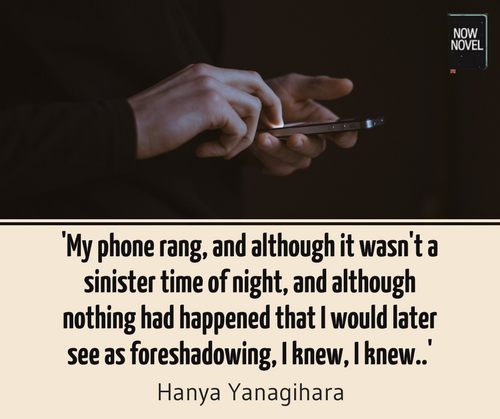Foreshadowing is one way to connect scenes in a story across your longer story arcs. Here are examples of how to use foreshadowing in a sentence, along with related foreshadowing tips:
1. Foreshadowing characters' fates in exposition
Foreshadowing (literally 'showing before') is useful for telling readers what happens to characters in a non-linear way. For example, here an opening sentence ominously foreshadows a character's fate:
'Many years later, as he faced the firing squad, Colonel Aureliano Buendía was to remember that distant afternoon when his father took him to discover ice.'
This sentence in Gabriel Garcia Marquez's One Hundred Years of Solitude (1967) plainly tells us that a main character will face a firing squad. Even though Marquez tells us what will happen, though, he makes this a strong hook because he doesn't reveal:
- Why the Colonel will be sentenced to death - many other events occur before we find out
- More details about the expedition to 'discover ice' Buendía takes with his father
With this direct foreshadowing that explicitly tells us what will happen, Marquez creates mystery. We don't know the 'why' or the exact 'when'. It's mysterious while also promising a dramatic turn of events, so it creates good suspense from the start.
If you foreshadow what happens to characters in your book, remember to note down what needs to happen later so you deliver on expectations you create.
2. Foreshadowing characters' qualities using dialogue
Dialogue also foreshadows future story developments well. Your characters could talk about an absent, important figure, long before we meet them.
J.K. Rowling uses dialogue this way frequently to build suspense in her Harry Potter series. The main villain's reputation precedes him through characters' fearful conversations.
For example:
"Well...I don' like sayin' the name if I can help it. No one does."
"Why not?"
"Gulpin' gargoyles, Harry, people are still scared. Blimey, this is difficult. See, there was this wizard who went... bad. As bad as you could go. Worse. Worse than worse. His name was..."
Hagrid gulped, but no words came out.
Here, the school's gamekeeper and 'Keeper of Keys' Hagrid is afraid to tell Harry the series' villain's name. Hagrid's fear in this dialogue foreshadows the terror the villain casts in his wake. The foreshadowing dialogue gives backstory as well as an idea of what to expect.
When foreshadowing a character's personality, think about their most important qualities and roles in the overarching story. Make dialogue preceding their entry make sense given your 'off-stage' character's core details.

3. Foreshadowing using signs in your setting
Setting is a useful tool for foreshadowing. You may be subtle or overt in how you use it to tease coming developments.
For example, in a horror novel a character might see a sign outside a haunted house. Say, for example, the sign has been vandalized:
'The sign once said 'Tresspassers will be prosecuted' but someone had graffiti'd out the 'prose-' to make it read '...will be electrocuted.'
If a character meets a sticky end involving electricity (for example, they're electrocuted while fleeing a paranormal phenomenon), the sign would be obvious setting foreshadowing.
A foreshadowing 'sign' does not have to be a literal road or property sign, of course. It could be an odour a character keeps smelling; a sound a character keeps hearing. It could be anything that sets up a suspenseful unknown and implies there's a story behind it.
When foreshadowing in a sentence describing your setting, remember to:
- Foreshadow significant events (you don't need to foreshadow what characters will have for breakfast, of course)
- Match the tone of your foreshadowing to the event - ominous signs typically foretell ominous events
You can of course subvert reader expectations. Your foreshadowing might not match the event, when it comes. Maybe the persistent, strange odour in the creepy house is actually coming from the factory down the road.
This type of misleading foreshadowing plays with readers' expectations, creating suspense. Use it with discretion, though. Over-used plot devices can become gimmicky.

4. Foretelling story events using running motifs
Recurring motifs or themes are also useful for foreshadowing events.
Toni Morrison uses this type of foreshadowing in her unflinching examination of the effects of slavery, Beloved (1987). A single sentence at the start of each section in the book, mentioning the address where the main characters live, foreshadows the tone of events in that section. For example:
'124 was spiteful. Full of a baby's venom.'
It's only in the course of the story that we understand why a house would be full of a baby's 'venom'.
Morrison's recurring motif - the similar sentences describing 124 as a changing, emotional, personified character - sets the tone for each section of the story. The phrase 'full of a baby's venom' foreshadows devastating events concerning the fate of the character Sethe's infant. '124 was spiteful', the opening line, also foreshadows subplots involving spite, such as when others in the village betray the main characters out of bitter envy.
Now try your hand at writing a few foreshadowing sentences. Write a sentence hinting:
- A character will receive a great windfall but doesn't know it yet
- A big environmental catastrophe is coming to a small town
- A narrator is unreliable and can't be trusted to tell the whole truth
An example using the first prompt:
'Driving over the river on his usual route to work, he almost crashed when he was distracted by a great glittering - some incredible treasure - in the corner of his eye. Yet when he looked at the water below he saw it was only shimmering light on a bird's metallic ruff.'
This description could foreshadow the character discovering great riches in the course of the story, for example.
For another example of foreshadowing, read our post on reading like a writer.










I believe I have used some foreshadowing. But then, maybe I'm thinking of the opposite, backstory. I do know that Jim Butcher uses foreshadowing in his Harry Dresden series. It is interesting how a mention of one person's behavior in one book turns that person into a main character in another. I really like the series.
Njn - About 7 years ago
I'll have to dip into the Harry Dresden series! Thank you for reading. As for the distinction between backstory and foreshadowing, you can indeed foreshadow backstory if a character's past is only shared later in the story. In other words, hint at riveting details about a character's past that you delay fully revealing.
Bridget At Now Novel - About 7 years ago
Great post. I do love to foreshadow: subtly, always subtly.
Joanne Burn - About 7 years ago
Thanks Joanne! My favourite kind, too. Thanks for reading.
Bridget At Now Novel - About 7 years ago
I would really love to write a novel with an unreliable narrator. I know (for the most part) how to go about it, but I'm not sure how I would foreshadow that. Any advice??
Talia - About 6 years ago
Hi Talia! Thanks for asking. One way to hint that your narrator is unreliable is to have them describe events and then have another viewpoint narrator in a different section contradict how they described events. For example in Nabokov's Lolita, the protagonist makes himself appear charming but then Nabokov shows how his actions affect Lolita and we're reminded how manipulative and abusive he is. I hope that helps!
Jordan At Now Novel - About 6 years ago